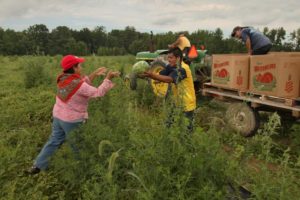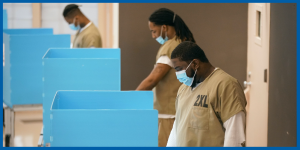Researchers have analyzed the DNA of enslaved African Americans who worked and died at an iron forge in Maryland, shedding light on their health, ancestry and revealing that they have tens of thousands of distant relatives or close descendants alive today.
The breakthrough study compared genetic information of 27 individuals buried in the cemetery of Catoctin Furnace, which also forged weapons in the Revolutionary War, with the DNA of some nine million people in the database of consumer genetics company 23andMe.
Within that pool, there were more than 41,000 people alive today who showed some genetic connection to the Catoctin individuals and almost 3,000 who were either their close relatives or direct descendants, a team of geneticists and historians reported Thursday in Science.
“What is unique about this study is the wedding of historical DNA analysis with large modern databases,” says Prof. David Reich, a geneticist at Harvard University who led the team. The method developed by the researchers to compare ancient and modern DNA opens up huge opportunities to understand migratory and reproductive patterns of historical populations and their impact on our present world, Reich adds.
For Black Americans specifically this is an opportunity to recover long-lost information on their ancestral connections to people forcibly brought over from Africa in the transatlantic slave trade, notes Dr. Éadaoin Harney, a researcher at 23andMe and the lead author on the paper.
As all good research does, the new paper also raises questions. Finding that such a small group of slaves in 18th and 19th century Maryland has such a large number of relatives and descendants in today’s African American community suggests the possibility that this population went through a genetic bottleneck similar to that experienced by Ashkenazi Jews in Europe, Reich says.

Weapons for Washington
The study was conducted with permission of the local preservation society, which was eager to shed light on the origins and modern connections of the people pressed into labor at the forge, Harney says. The skeletons were excavated from the Catoctin African American Cemetery in 1979-1980 ahead of highway construction and have since been in the care of the Smithsonian Institution.
Catoctin Furnace began operating in 1776, smelting iron mined from nearby deposits, and toward the end of the Revolutionary War it churned out ammunition for the Continental Army. From its inception, the forge used enslaved African American laborers, as well as some free people of color, transitioning fully to paid workers only around 1850.

The skeletons sampled in this study belonged to people who died between 1776 and 1850, though the tombs had no gravestones so it is not possible to identify the deceased or their precise dates of birth and death. But the analysis could shed some light on their identities: 15 of them belonged to five distinct families, composed of mothers, children and siblings, while the remaining 12 were genetically unrelated, the researchers report.
The geneticists then compared their DNA to some 9.2 million people who used 23andMe’s services and had consented to having their genetic information used for research. To do this, the scientists developed a method to measure and compare the length of identical-by-descent DNA strands in the Catoctin individuals and the modern-day genomes.
All humans share more than 99 percent of their genome – but that still leaves millions of base pairs that make us genetically unique (unless we have an identical twin). And if two people share strands of DNA in those unique sections of the genome, it means they have a common ancestor. The longer those identical-by-descent strands, the closer the family relation.

Many studies have compared ancient DNA to generally small, modern databases. The large 23andMe dataset has been tapped before, including for a study on the genetic effects of the transatlantic slave trade, but this is the first time that such a massive database is compared to historical DNA to identify direct relations to specific people alive today, Reich says.
Who’s your great-great-great-grandpa?
Most of the 41,000 hits in the modern database are so-called “collateral” relatives, Harney explains. “These are not direct descendants. They only share pretty small segments of DNA, which could trace back to a shared common ancestor who lived centuries or maybe 1,000 years ago back in Africa, so most of those connections are quite distant,” she tells Haaretz.
There are however nearly 3,000 people who have such a large amount of shared DNA that they must be related to within the ninth degree to the Catoctin individuals, meaning they are either direct descendants or descendants of someone closely related, such as a cousin or grandparent, Harney says.
If we were to project these results on the entire African American population, based on the findings in the 23andMe database, we would find that out of more than 40 million Black people in the United States, about four percent, or around two million, shared some distant ties to the Catoctin individuals, Reich says.
“That’s a lot of people,” he notes, adding that this data points to an unanswered question about the history of African Americans in the United States: whether they went through a genetic bottleneck, or, in other words, whether the modern population descends from a relatively small group of people. Such a bottleneck is believed to have been the founding event, which occurred at some point during the early Middle Ages, of all modern Jewish Ashkenazi populations. Did the something similar happen to African Americans?
We know that about half a million slaves were brought to the United States (or what would become the US) between 1501 and 1867 directly from Africa or through the Caribbean, but we don’t know how many contributed to the modern population.
“Many of those died without leaving children so it’s possible there may be a limited number of founders for the African American population,” Reich says. “There are hints in the literature that that’s actually the case. The people who successfully reproduced and gave rise to later generations may have been relatively few and you may have a founder event similar to what you see in Ashkenazi Jews, although probably not as strong.” Still, much more genetic data from different times and places will be needed to make a determination, he adds.

Where are they now?
Most of the 3,000 close relatives detected through the research are located in Maryland. This is important as studies of genealogical records had not been able to show that any of the African Americans laborers at Catoctin stayed in the area at all, Reich says. Other large clusters of related individuals can be found in the southern U.S. states and in California.
At this time, none of the relatives detected in the study have yet been told they may have an ancestral connection to the people enslaved at Catoctin.
“To protect individual privacy, the data in the study is reported on aggregate and anonymized,” Harney says.
“At present there is no mechanism in place to give the subjects in the 23andMe database the opportunity to learn about genetic connections that have been found,” Reich adds. “However, I have every hope that this will become possible soon.”
The research also looked at the African ancestry of the Catoctin individuals, and found that they were mostly connected to groups from two very distant regions: today’s Senegal and Gambia in western Africa, and Angola and the Democratic Republic of the Congo in central Africa.
This was unexpected, because African Americans today trace most of their ancestry to the regions around Nigeria and Cameroon. But it is consistent with historical records on the points of origin of slaver ships that reached Maryland in that period, Harney says.
Eight of the 27 people from the Catoctin cemetery also had varying degrees of European ancestry, mainly traceable to Ireland and Great Britain and overwhelmingly connected to their paternal side. This likely reflects the known historical phenomenon of enslaved women being raped by their European enslavers, the researchers conclude.
There was one individual who displayed European ancestry in mitochondrial DNA, which is inherited from the mother’s side. This may have been an example, also well-known from historical records, of enslaved or free Black men having children with white women, usually indentured workers, the authors report.

A giant leap forward
The DNA analysis also revealed some insights about the health of the Catoctin individuals, including that several carried risk factors for sickle cell anemia and G6PD deficiency, two genetic disorders that cause red blood cell abnormalities that are still very common among African Americans. Two of those affected at Catoctin were siblings who died in childhood, and sickle cell anemia may have contributed to their early demise, the researchers note.
“One of the goals here is to restore some degree of humanity and memory to the people we are analyzing and not treat them just as samples,” Reich says. “Just reporting that this person was ill and died young, or that this other person has a direct descendant probably living in Los Angeles – all these are small meaningful things we can say to restore their memory.”
The new method developed by Harney and colleagues to trace the descendants of the Catoctin individuals offers major opportunities for African Americans to learn about their ancestry despite the paucity of records from before the abolition of slavery, says study co-author Henry Louis Gates Jr., a Harvard professor of African American studies and host of the genealogy TV show “Finding Your Roots.”
“Even if we don’t — and will never — know their names, this study allowed us to make connections between individuals who died more than 200 years ago and their living descendants,” Gates says. “Recovering African American individuals’ direct genetic connections to ancestors heretofore buried in the slave past is a giant leap forward both scientifically and genealogically, opening new possibilities for those passionate about the search for their own family roots.”




